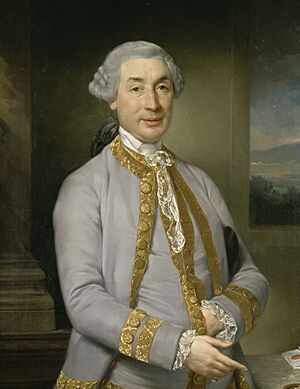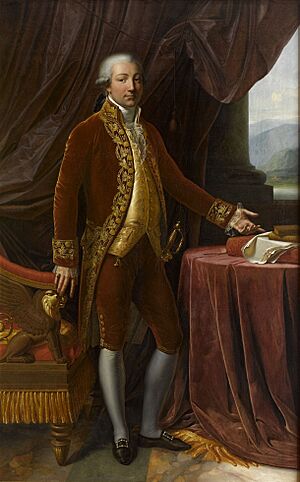Carlo Buonaparte facts for kids
Quick facts for kids Carlo Buonaparte |
|
|---|---|
| Noble Patrician of Tuscany | |
 |
|
| Portrait attributed to Anton Raphael Mengs, between c. 1766–1779 | |
| Spouse(s) | |
| Issue | |
| Full name | |
| Carlo Maria Buonaparte | |
| Noble family | Buonaparte |
| Father | Giuseppe Maria Buonaparte |
| Mother | Maria Saveria Paravicini |
| Born | 27 March 1746 Ajaccio, Corsica, Republic of Genoa |
| Died | 24 February 1785 (aged 38) Montpellier, Kingdom of France |
| Burial | Imperial Chapel, Ajaccio, France |
Carlo Maria Buonaparte (born 27 March 1746 – died 24 February 1785) was a Corsican lawyer. He is most famous for being the father of Napoleon Bonaparte, who later became the Emperor of the French. Carlo was also the grandfather of Napoleon III.
Carlo Buonaparte worked for a short time as an assistant to Pasquale Paoli, a leader who wanted Corsica to be independent. Carlo fought with Corsican forces against the Genoese republic. After Corsica became part of France, Carlo became a representative for Corsica in 1777. He went to the court of Louis XVI, the King of France. Twenty years after Carlo's death, his second son, Napoleon, became the Emperor of the French. Many of Carlo's other children also received royal titles from their brother and married into royal families.
Carlo's Early Life
Carlo Buonaparte was born in 1746 in Ajaccio, a town on the island of Corsica. At that time, Corsica was part of the Republic of Genoa. Carlo had an older sister, Maria Gertrude, and an older brother, Sebastiano. His father, Giuseppe Maria Buonaparte, had represented Ajaccio in a local council in 1749.
The Buonaparte family in Corsica originally came from Tuscany, a region in Italy. One of Carlo’s ancestors, Guglielmo di Buonaparte, was part of the city council in Florence in the 1200s. When a different political group took over Florence, Guglielmo and his family moved to Sarzana. Later, in the 1500s, Guglielmo’s descendant, Francesco di Buonaparte, sailed from Liguria (another part of Italy) to Corsica to start a new life.
Carlo first planned to follow in his father's footsteps. He began studying to become a lawyer at the University of Pisa in Italy. However, his father passed away, and Carlo inherited a lot of money. He left his studies before finishing his degree to manage his inheritance and take care of his family.
On 2 June 1764, Carlo married Maria Letizia Ramolino, who was fourteen years old. Her family, the Ramolinos, were also from a noble background in Italy and had lived in Corsica for 250 years. Their marriage was arranged by their families. They considered things like their shared language, church customs, food, and other family traditions. Carlo’s new wife brought a dowry, which was like a gift of property. This included about thirty-one acres of land, a mill, and a bakery, which brought in a good income each year.
Corsica Becomes French
After his marriage in 1764, Carlo worked as a secretary and assistant for Pasquale Paoli. Paoli was a leader who wanted Corsica to be independent. Carlo and Letizia had a son named Napoléon in 1765, but he died as a baby. They also had a daughter who died very young.
In 1766, Paoli sent Carlo to Rome to talk with Pope Clement XIII. Carlo enjoyed his time in Rome. However, he had to return to Corsica in 1768 for reasons that are not fully known.
When Carlo returned, the Republic of Genoa had offered to give Corsica to King Louis XV of France. This was to pay off a debt. France wanted the island because it was in a good location to protect their own coasts. Genoa was happy to give up control because they couldn't stop the growing independence movements in Corsica.
This change caused a lot of political trouble. Many of Paoli's supporters had to hide in the mountains. Carlo and his family, including their new baby, Giuseppe (who was their first child to survive infancy), were among them. The family eventually returned to town. There, Carlo's wife gave birth to their fourth child, Napoleone, who would later become famous.
Soon after France took over Corsica, Carlo Buonaparte accepted the new French government. He was appointed as an Assessor (a type of judge or legal advisor) for the Royal Jurisdiction of Ajaccio and nearby areas on 20 September 1769. A short time later, he earned his degree as a Doctor of Law from the University of Pisa on 27 November 1769.
Carlo's Rise to Importance
In April 1770, the French government created a special group for Corsican nobles. Carlo Buonaparte became an advocate (a lawyer who speaks in court) for the Superior Council of Corsica in December 1769. He also became a special lawyer for the King of France in Ajaccio in October 1770.
Carlo already had the title of a "Noble Patrician of Tuscany" since 1769 because of his family's history. This title was confirmed in September 1771. He then became an assessor for the Royal Jurisdiction of Ajaccio in February 1771. He was chosen as a representative for the nobles in Corsica in September 1771. In May 1772, he became a member of an important council of twelve nobles. In July 1777, he became a representative for the Corsican nobility at the French Royal Court. Finally, in 1778, he was named Corsica's main representative to the court of Louis XVI of France at Versailles.
Even though he received many important titles, Carlo Buonaparte was not always satisfied. He often took part in risky business deals. He tried to claim land and money through legal ways, but he didn't have much success. He spent his money very quickly. His love for gambling also made his money problems worse. Carlo wrote in his account book: "In Paris, I received 4,000 francs from the King and a fee of 1,000 crowns from the government, but I came back without a penny."
By 1782, Carlo Buonaparte started to feel weak and was in constant pain. He traveled to Montpellier in France to get medical help. Doctors believed he had stomach cancer, which might have been the same illness that later affected his son Napoleon. Carlo Buonaparte died on 24 February 1785. Because of his spending, he left his wife and eight children with no money. His youngest son, Jérôme, was born just three months before Carlo died.
Carlo's Children
Carlo Buonaparte and Letizia Ramolino had thirteen children between 1765 and 1784. Five of them died either at birth or as infants. Eight children survived to adulthood:
- An unnamed daughter (1765).
- Maria Anna Buonaparte (1767 – 1768).
- Joseph Bonaparte (born 1768 – died 1844): He became the King of Naples and Sicily, and later the King of Spain. He married Marie Julie Clary.
- Napoleon Bonaparte (born 1769 – died 1821): He became the Emperor of the French. He married Joséphine de Beauharnais and later Marie Louise, an Archduchess of Austria.
- Maria Anna Buonaparte (1771 – 1771).
- A stillborn child (1773).
- Lucien Bonaparte (born 1775 – died 1840): He became the Prince of Canino and Musignano. He married Christine Boyer and later Alexandrine de Bleschamp.
- Maria Anna (Elisa) Bonaparte (born 1777 – died 1820): She became the Grand Duchess of Tuscany. She married Felice Pasquale Baciocchi.
- Louis Bonaparte (born 1778 – died 1846): He became the King of Holland. He married Hortense de Beauharnais.
- A stillborn son (1779).
- Pauline Bonaparte (born 1780 – died 1825): She became the Sovereign Princess and Duchess of Guastalla. She married Victor-Emmanuel Leclerc and later Camillo Borghese, 6th Prince of Sulmona.
- Caroline Bonaparte (born 1782 – died 1839): She became the Grand Duchess of Berg and Cleves. She was the wife of Joachim Murat, who later became the King of Naples.
- Jérôme Bonaparte (born 1784 – died 1860): He became the King of Westphalia. He married Elizabeth Patterson, then Princess Katharina of Württemberg, and later Justine Bartolini-Baldelli.


